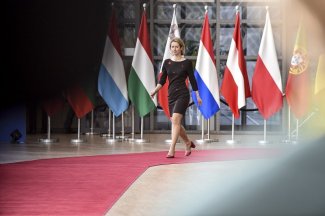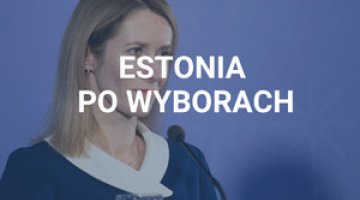The Kaja Kallas era: Estonia’s high-profile diplomacy

Russia’s invasion of Ukraine served as a catalyst for Estonian diplomacy. The narrative of a country of one million people on the periphery of the European Union, warning of the real threat posed by Russia, has become one of the most influential voices on NATO’s eastern flank and has helped shape debate within the EU. Tallinn’s success stemmed from a convergence of several factors: a surge in European criticism of Russia, the concerted efforts of the Estonian state apparatus, and the charisma of then-Prime Minister Kaja Kallas. It was her standing, network of contacts, and political style that gave Estonia’s voice resonance and ultimately enabled her to assume the role of EU High Representative for Foreign Affairs. However, both Tallinn and Kallas now face the challenge of maintaining this hard-won position. This is particularly important given the need to translate Kallas’s critical stance on Russia into political decisions, some of which are likely to meet with scepticism from certain European countries.
Ukraine first
The outbreak of full-scale war in Ukraine brought significant changes to the formulation of Estonia’s foreign policy. Prime Minister Kaja Kallas (in office from 2021 to 2024) played a key role, sidelining successive foreign ministers.[1] As a result, she came to be seen internationally as the face of Estonian diplomacy. During this period, Tallinn made political, moral and material support for Ukraine its top priority.[2] Kallas’s words in April 2022 were symbolic: ‘What is our neighbour’s [Ukraine’s] problem today will be our problem tomorrow. We are in danger when our neighbour’s house is on fire’.[3]
Kallas’s foreign policy course did not differ much from that of her predecessors. Estonia’s foreign policy has always been shaped by its proximity to Russia, which has determined the country’s strategy and actions. Until 2004, Estonia aimed to join Western structures – NATO and the EU – while also deepening relations with the Nordic and Baltic states. After 2014, security issues came to dominate foreign policy. This led to the expansion and strengthening of bilateral cooperation. Estonia’s key partner in this field is the United States, followed by the United Kingdom, which leads the NATO battlegroup stationed in the country.[4] Tallinn also maintains a special security relationship with Paris – French armed forces are present in Estonia, while Estonia has been actively involved in French operations in the Sahel.[5] Regional cooperation in the Nordic-Baltic region also plays a significant role in Estonia’s regional policy, particularly with Finland, which shares the same cultural heritage and is Estonia’s closest economic partner.
Kallas steps ahead of the pack
By spring 2025, Estonia’s military assistance to Ukraine had exceeded €500 million, with over €26 million allocated to humanitarian aid and at least €12 million to development support.[6] Estonia’s contribution became an effective instrument of its public diplomacy, which emphasised that Tallinn was among the leading providers of aid to Kyiv relative to GDP. [7]
Moreover, Estonia was one of the first countries to officially announce the delivery of weapons (anti-tank grenade launchers) to Ukraine. Through this stance, it sought to break political taboos surrounding declarations on arms supplies.[8] Its support for Kyiv, along with the high profile of the Estonian Prime Minister, attracted the attention of Western media. Kallas strongly criticised not only Russia’s invasion and its war crimes but also the lack of leadership – and even disorientation – among major European states such as France and Germany.[9] In doing so, she crafted a media-friendly image: a young, courageous politician who was also part of the European liberal mainstream. The Estonian Reform Party, which Kallas then led, belongs to the same political group (Renew Europe) as Emmanuel Macron’s Renaissance party.
The media success of Kallas – hailed as the ‘Estonian Iron Lady’,[10] a future NATO Secretary General or a personal adversary of Vladimir Putin wanted by Russia’s Ministry of Internal Affairs – had a positive impact on the visibility of the entire country.
This reputational success was leveraged as a means of advancing Estonia’s interests. Tallinn employed a strategy characteristic of small states – ‘leadership by example’ – which, under favourable conditions and in certain policy areas, proved effective. The introduction of national sanctions against Russia, decisions to increase defence spending, and proposals such as allocating 0.25% of GDP annually to support Ukraine reflected Estonia’s ambition to set the direction of foreign policy for other European countries. Estonia aimed to pursue an effective policy beyond its means and resources, and the media attention surrounding Kallas helped to make this possible to a certain extent. Tallinn was able to influence the European debate.
Kallas, Macron and the path to Europe
Over time, Estonia’s efforts to continue its policy of ‘leading by example’ began to lose effectiveness, or at least did not yield the results suggested by media headlines and Kallas’s international popularity. Nevertheless, Estonia succeeded in promoting some of its own proposals,[11] such as the EU initiative in spring 2023 to supply Ukraine with artillery ammunition. It also appears to have achieved some success in advocating for the use of frozen Russian assets by the EU.[12]
However, its influence began to wane as early as 2023. On the one hand, this was due to domestic issues faced by Kallas, particularly the scandal involving her husband, Arvo Hallik – Estonian media revealed that a company in which he held shares continued operating in Russia. On the other hand, shaming larger European countries was becoming less effective. As these states rapidly adopted a firmer stance towards Moscow and began to regain the initiative, Tallinn found that, in order to achieve its objectives, it needed to identify partners among them.
Paris proved to be a rational choice – despite occasional criticism of President Macron.[13] A favourable factor was the shift in France’s foreign policy at the turn of 2022 and 2023, when it moved from seeking an agreement with Russia to adopting a more assertive stance in support of Ukraine.[14] Kallas’s contacts within the European liberal bloc also played a beneficial role.
Since the Russian invasion of Ukraine, France’s military presence in Estonia (ongoing since 2017) was modified to a continuous rotational model. As part of exercises, it has periodically been reinforced with reconnaissance units, artillery elements, and even paratrooper companies. In return, Tallinn showed increased interest in French defence industry products. In summer 2023, it ordered additional GM 400 radars from Thales,[15] procured twelve CAESAR self-propelled howitzers[16] and an unspecified number of very short-range surface-to-air missiles for the MISTRAL systems.[17] Over the past three years, France has become Estonia’s third-largest arms supplier, following Germany and the United States.
In autumn 2023 and spring 2024, political ties between Estonia and France were further strengthened. Kallas’s frequent visits to Paris aimed to reinforce Tallinn’s political influence and highlight France’s support for Ukraine and its presence on NATO’s eastern flank.[18] This deepening of relations also raised Kallas’s profile in European politics. Her nomination and subsequent appointment as the EU High Representative for Foreign Affairs in mid-2024 would not have been possible without the backing of the liberal faction in the European Parliament and the support of France.[19]
Always the Prime Minister
Kallas’s appointment as EU High Representative for Foreign Affairs raised specific hopes among NATO’s eastern flank countries, such as Poland, the Baltic states, and the Nordic nations. Expectations centred on maintaining focus on the war in Ukraine[20] and steering EU foreign policy towards a more active stance. The region’s foremost hope was for a more stringent approach towards Russia. Reflecting this, Kallas brought an Estonian sensitivity and the perspective of frontline states to her new role. This was evident in her remarks during her first visit to Kyiv as High Representative, where she declared, “The European Union wants Ukraine to win this war”.
However, in some EU circles, Kallas’s prioritisation of Russia’s ongoing invasion was viewed as a weakness in her new role.[21] Her statement in Kyiv drew criticism from Olaf Scholz, and Hungary has maintained a sceptical stance towards her. Other contentious areas within the EU include policies on the Middle East, the Global South, and EU enlargement. The frontline-state perspective represented by Kallas also remains difficult to fully grasp in Southern Europe. Yet her main challenge is not opposition from European states or politicians who disagree with her views, but in her political style.
Kallas’s past political activity at the national level suggests a difficulty in building consensus on issues she considers fundamental, such as support for Ukraine. In Estonia, she frequently made decisions that ran counter to the views of her coalition partners or public opinion. According to Estonian political observers, her defining trait as prime minister was a difficulty in reaching compromise and working collaboratively within a coalition government.[22] The qualities that marked her domestic political conduct – tenacity, determination, and sharp rhetoric – helped her gain prominence in European political circles. However, these traits are largely counterproductive in a role defined by the need to build broad consensus among 27 EU member states.[23]
It was likely Kallas’s inflexibility that contributed to the failure of one of her first major initiatives – an EU aid package for Ukraine[24] – in March 2025. European media, previously supportive of her, began criticising her for a lack of professionalism and reluctance to engage in dialogue, arguing that she still behaves as if she were a national prime minister.[25] Outlets such as Frankfurter Allgemeine Zeitung and Politico, citing Brussels-based politicians, pointed to her failure to conduct broader consultations or seek wide support for the proposal before presenting it. Kallas faces a fundamental tension in her role – she aspires to lead EU foreign policy in a time of global instability while also needing to act as a broker of compromise among 27 member states. Her central challenge is to overcome the entrenched and cautious patterns that characterise the workings of the Brussels bureaucracy.
In search of a new place in Europe
Kallas’s move to the European level marked the end of a distinct chapter in Tallinn’s foreign policy. The new prime minister, Kristen Michal, and the former foreign minister, Margus Tsahkna,[26] who now oversee foreign affairs, lack both the influence and prominence once held by Kallas. Although Estonia continues to follow the policy framework established by Kallas, it is no longer achieving the expected results. Tallinn’s proposals no longer generate significant media attention and, as a result, are increasingly absent from the European debate. At present, Estonia retains a degree of informal influence on the EU agenda, primarily due to Kallas’s presence in Brussels.
The key to Estonia’s successes between 2022 and 2024 lay in effective leadership that captured the attention of Europe’s political elite and media, while advancing several Estonian initiatives to support Ukraine. Today, the challenge is not only the absence of strong leadership but also the need to adapt to a rapidly evolving international landscape following Donald Trump’s return to the US presidency.
Tallinn must now strike a balance between previously complementary paths – predictable cooperation with European allies such as the United Kingdom and France, and engagement with an increasingly unpredictable United States. Estonia’s diminished position as a leading supporter of Ukraine and advocate of a more assertive stance on Russia reflects global shifts more than genuine marginalisation.
In the near future, Estonia’s declining prominence in European politics will likely be offset by deeper involvement in regional cooperation, particularly within the Nordic-Baltic Eight (NB8). Although the format has existed since the early 1990s, cooperation has recently intensified, and for Tallinn, the NB8 represents a club of like-minded states.
[1] In the three cabinets formed by Kallas, the position of foreign minister was held by: Eva-Maria Liimets (delegated by the Centre Party), Urmas Reinsalu (Isamaa), and Margus Tsahkna (Estonia 200).
[2] Government approves Estonia’s EU policy priorities for 2023-2025, Estonian government, 26 June 2023, valitsus.ee.
[3] ‘Kaja Kallas: ‘Our neighbor’s problem today will be our problem tomorrow’’, Eesti Rahvusringhääling, 26 April 2022, news.err.ee.
[4] Forward Land Forces (FLF).
[5] A counterterrorism military operation carried out in the Sahel region by French armed forces alongside allies. The Estonian contingent was present there from 2018 to 2022.
[6] Estonia’s aid to Ukraine, Estonia’s Foreign Affairs Ministry, 23 February 2025, vm.ee.
[7] ‘Estonia’s total military aid to Ukraine to date approaching €300 million’, Eesti Rahvusringhääling, 18 November 2022, news.err.ee.
[8] The transfer of nine former East German D-30 howitzers from Tallinn to Ukraine played an important role in amplifying Estonia’s voice. This equipment had been supplied to the Estonian armed forces from Germany via Finland in 2009. Delivering it to Kyiv required overcoming Germany’s then-prevailing concerns about supplying weapons to Ukraine. See ‘Kusti Salm: We must inspire Germany to provide more aid to Ukraine’, Eesti Rahvusringhääling, Eesti Rahvusringhääling, 20 January 2023, news.err.ee, and ‘Germany blocks Estonian arms exports to Ukraine: report’, Deutsche Welle, 21 January 2022, dw.com.
[9] S. Erlanger, ‘Estonia’s Tough Voice on Ukraine Urges No Compromise with Putin’, The New York Times, 16 May 2022, nytimes.com.
[10] She was nicknamed so by Western media, drawing a comparison with British Prime Minister Margaret Thatcher, who held office from 1979 to 1990.
[11] ‘EU approves Estonia’s initiative to jointly send 1 mln artillery shells to Ukraine’, Postimees, 20 March 2023, news.postimees.ee.
[12] M. Tsahkna, ‘Foreign minister: Frozen Russia assets should be used to rebuild Ukraine’, Eesti Rahvusringhääling, 17 October 2023, news.err.ee.
[13] S. Lau, E. Hartog, ‘Europe’s next top diplomat is ready to be undiplomatic’, Politico, 9 December 2024, politico.eu.
[14] Ł. Maślanka, ‘Twilight of Jupiter: The Legacy of Macron’s Foreign and Security Policy’, OSW Commentary, no. 613, 18 July 2024, osw.waw.pl.
[15] ‘Estonia buys two airborne radars to construct new wind farms’, Eesti Rahvusringhääling, 21 June 2023, news.err.ee.
[16] ‘Estonia signs Mistral joint procurement deal with 4 EU countries’, Eesti Rahvusringhäälin, 19 June 2024, news.err.ee.
[17] ‘Germany replaces USA as Estonia’s biggest arms supplier’, Eesti Rahvusringhäälin, 19.03.2024, news.err.ee.
[18] In October 2023, during an official visit to Paris, the Estonian Prime Minister thanked President Macron for his leadership and firm stance on the ongoing war in Ukraine. She also participated in an anniversary forum organised by L’Express magazine. They subsequently met in France in November, February 2024, and May 2024. During the latter meeting, Kallas held talks with Macron and Prime Minister Gabriel Attal, and delivered a lecture at the Sorbonne. Source: A. Gyldén, ‘Kaja Kallas, Première ministre d’Estonie, invitée des 70 ans de L’Express’, L’Express, 12 October 2023, lexpress.fr; ‘Prime Minister Kallas to discuss EU enlargement and future with other political leaders in Paris’, Estonian government, 28 November 2023, valitsus.ee; ‘Prime Minister Kallas in Paris: We must act now to help Ukraine’, Estonian government, 27 February 2024, valitsus.ee.
[19] ‘Kallas: I will not be ALDE's European elections lead candidate’, Eesti Rahvusringhäälin, 7 March 2024, news.err.ee.
[20] J. Liboreiro, ‘‘Russia can’t really be trusted’, Kaja Kallas warns ahead of new Trump-Putin call’, Euronews, 17 March 2025, euronews.com; K. Bondarieva, ‘EU chief diplomat believes Ukraine can win war with EU’s help’, Ukrainska Pravda, 22 January 2025, pravda.com.ua.
[21] M.G. Jones, ‘Kaja Kallas under pressure to prove diplomatic prowess beyond EU’s eastern flank’, Euronews, 7 September 2024, euronews.com.
[22] T. Saarts, ‘Ebaharilik peaminister Kaja Kallas’, Postimees, 8 July 2024, arvamus.postimees.ee.
[23] T. Eilat, ‘Kaja Kallas’ road to becoming the best-known Estonian’, Eesti Rahvusringhääling, 5 September 2024, news.err.ee.
[24] J. Liboreiro, ‘Kaja Kallas’ €40-billion plan for Ukraine flounders at EU summit’, Euronews, 21 March 2025, euronews.com.
[25] N. Vinocur, J. Barigazzi, ‘EU plan to send more military aid to Ukraine in shambles’, Politico, 20 March 2025, politico.eu.
[26] Michal’s coalition cabinet was formed in July 2024. The coalition supporting the government consisted of the Reform Party, Estonia 200, and the Social Democratic Party. In March 2025, the coalition collapsed; a second Michal cabinet was established, comprising ministers from the Reform Party and Estonia 200.





